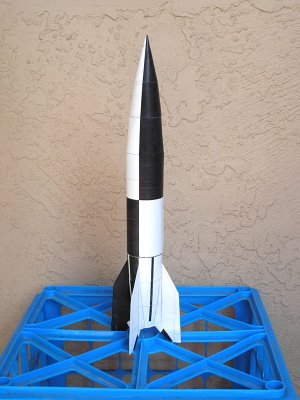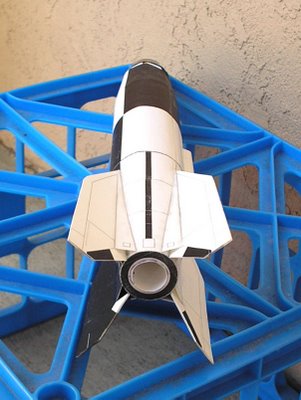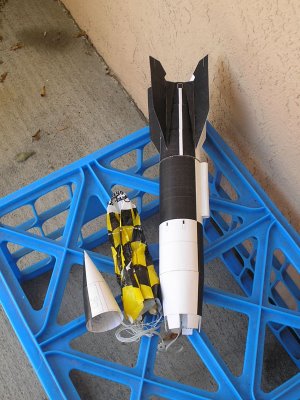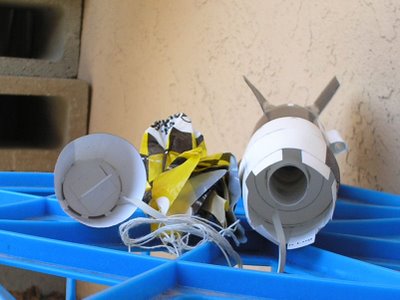Currell Graphics V2

I have a hard time building one rocket as a time. Inevitably, as the glue is drying on some delicate construction, I get antsy and want to put something else together. When I started building the Thunderhawk, I thought it would be done in a week and I'd be on to other things. I ended up spending a month on it and building several other rockets in the meantime.

The first two were paper rockets. I was introduced to paper models a couple of years ago when I stumbled across Ralph Currell's site. When I was a kid, I built a lot of model airplanes. Building models has always appealed to me, but I enjoy the construction a lot more than the finishing. I didn't want to built a kitted plastic model airplane. It's too cookbook, and I don't see much point in doing that as an adult unless I am going to produce a competition-quality finish, which I'm not interested in and am probably incapable of anyway. Model rockets appeal to me because they do something. Paper models appeal to me because they are more satisfying to build than plastic models. You start with a few sheets of cardstock, make the components, and assemble them into something that looks awesome. Model rockets built out of paper are appealing for all kinds of reasons. One of the major attractions is building a model rocket that doesn't cost anything. V2 kits are not common, and pricey enough that I wouldn't want to screw up the build (which is why my Estes Canadian Arrow is still in its bag). But a paper V2 kit can be downloaded, printed, cut, and finished in two days, for free and without risk. As paper modeling advocates are fond of pointing out, if you screw up the build, just print out some more parts and start over.

I built Ralph's R101 airship a couple of years ago and really enjoyed both the process and the result, so I decided to give his V2 a whack. It was an easier build than the airship, mainly because the body sections are perfectly round instead of ribbed. Also, I cheated on the fins. Instead of building up an internal framework of ribs as the instructions call for, I just laminated several layers of cardstock to thicken and strengthen the fins. As designed by Ralph, it is a static display model, but lots of people have modified it to fly on standard model rocket motors. I used a free paper flying model rocket, the Fliskits Midnight Express, for the "guts" of the V2. I flew the V2 last weekend, and it performed flawlessly. I'll fly it till it dies, then build another.

Irritatingly, I didn't get any photos of the V2 on the pad or in the air. Oh well, I guess I'll just have to go fly it again. Bummer!
Oh, I mentioned in the second paragraph that I built two paper models. The other one will be the subject of an upcoming post.

0 Comments:
Post a Comment
<< Home